Physical Address
304 North Cardinal St.
Dorchester Center, MA 02124
Pelvic ultrasound is the key imaging modality in the diagnosis of early pregnancy and its associated complications. Both transabdominal and transvaginal sonography (TVS) techniques are used.
The intradecidual sign refers to an eccentric, extraluminal, rounded, cystic structure located within the endometrium. It is the earliest imaging sign of an intrauterine pregnancy (IUP) on TVS and is observed as early as 4½ weeks of menstrual age.
The hyperechogenic peripheral decidua vera and the inner decidua capsularis with intervening anechoic endometrial lumen is seen on TVS at about 5 menstrual weeks ( Fig. 24.1 ).
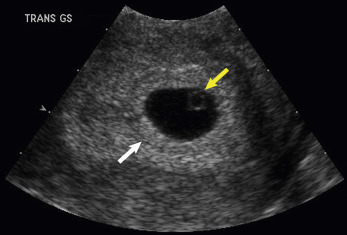
The gestational sac (GS) is composed of anechoic amniotic fluid and chorionic extraembryonic coelom, which may contain low-level echoes.
With TVS, the yolk sac (YS) is usually visualized within the extraembryonic coelom at approximately 5½ weeks or 8-mm mean sac diameter (MSD). It appears as a thin-walled, circular structure with an anechoic center. A normal YS measures less than 5.6 mm internal diameter between 5 and 10 weeks and starts to regress by 11 weeks. The YS is no longer seen after the amniotic cavity expands to obliterate the chorionic cavity by 14 to 16 weeks.
The embryo is first visible at approximately 6 weeks of gestational age as a 1- to 2-mm structure at the periphery of the YS. The length of the embryo is measured from the head (crown) to the buttocks (rump), hence the term crown–rump length (CRL), which is the most accurate measurement of gestational age through the first 12 weeks of pregnancy. The embryo should be visualized when the MSD is at least 25 mm ( Fig. 24.2 ).
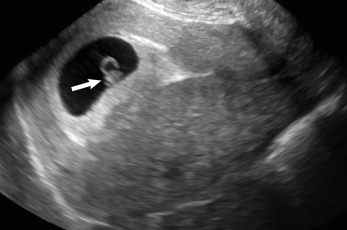
The embryo resides within the amniotic cavity. It is possible to observe cardiac activity in embryos as small as 1 to 2 mm. However, absence of cardiac activity in embryos smaller than 4 mm may also be normal. The embryonic heart rate accelerates over the first 6 to 8 weeks of gestation, with the lower limit of normality near 100 beats per minute at 6.2 weeks of gestation and 120 beats per minute at 6.3 to 7.0 weeks of gestation.
Embryonic morphology is rather featureless until 7 to 8 weeks, when the spine can be visualized. At approximately 8 weeks of gestation, the head curvature can be separated from the body and the four limb buds become apparent. The rhombencephalon, which is the developing hindbrain, is a prominent landmark at 8 to 10 weeks of gestation, appearing as an anechoic, round structure within the head.
It is important to determine the number of fetuses and their chorionicity and amnionicity in the first trimester, when it is easiest.
Dichorionic diamniotic: The twin peak sign is reliable evidence of dichorionicity. Both the amnions and the chorions reflect away from the placental surface, creating a potential space into which villi can grow. There is a thick intertwin membrane ( Fig. 24.3 ).
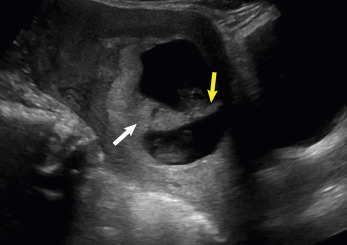
Monochorionic diamniotic: A single layer of continuous chorion limiting villous growth. There is a thin intertwin membrane separating the two amniotic cavities ( Fig. 24.4 ).
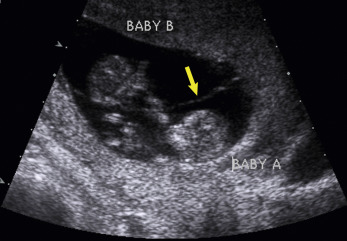
Monochorionic monoamniotic: No intertwin membrane ( Fig. 24.5 ).
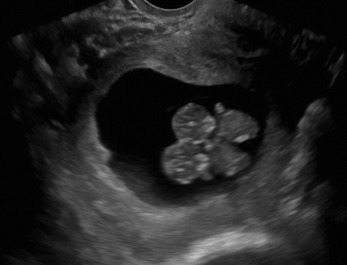
Become a Clinical Tree membership for Full access and enjoy Unlimited articles
If you are a member. Log in here